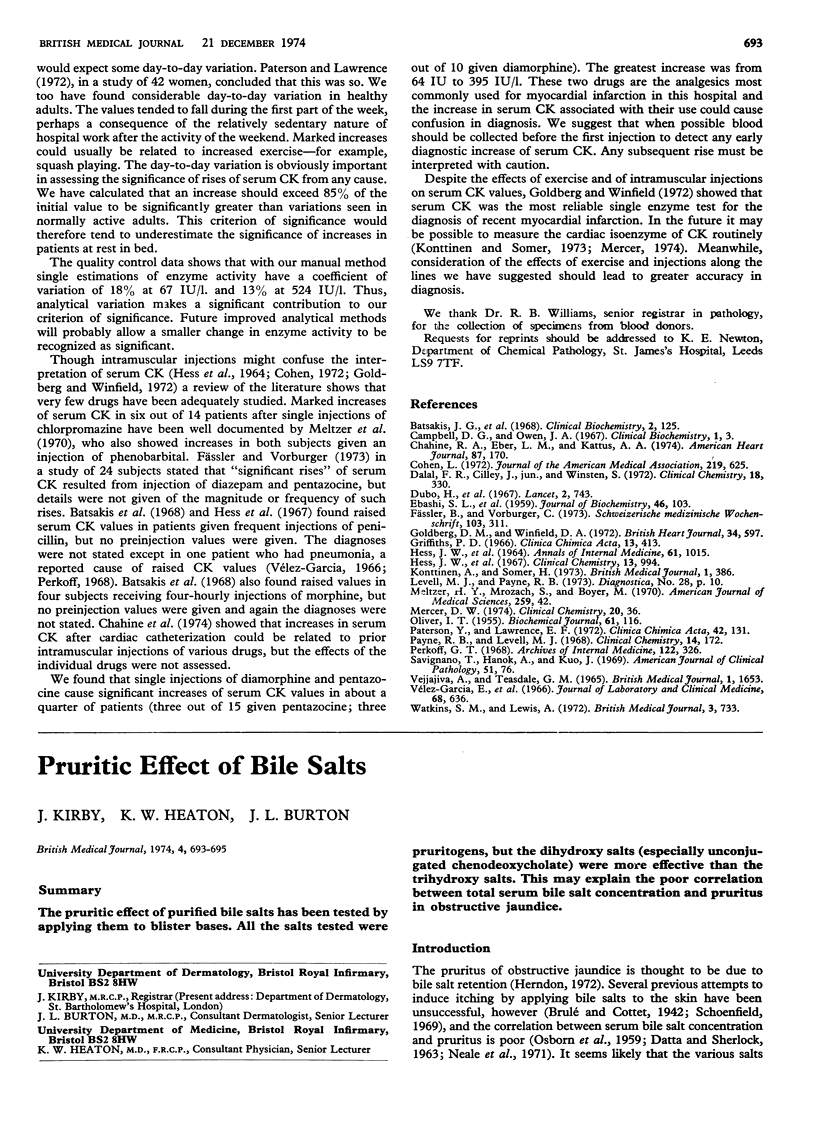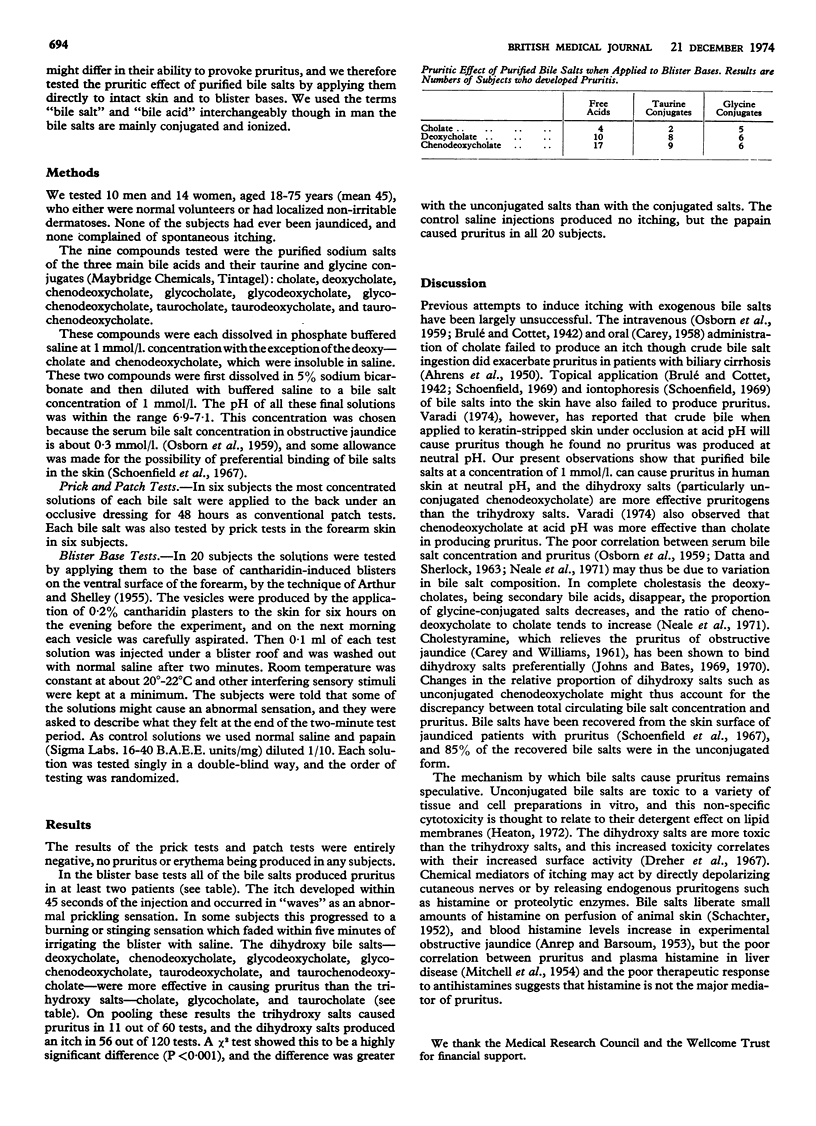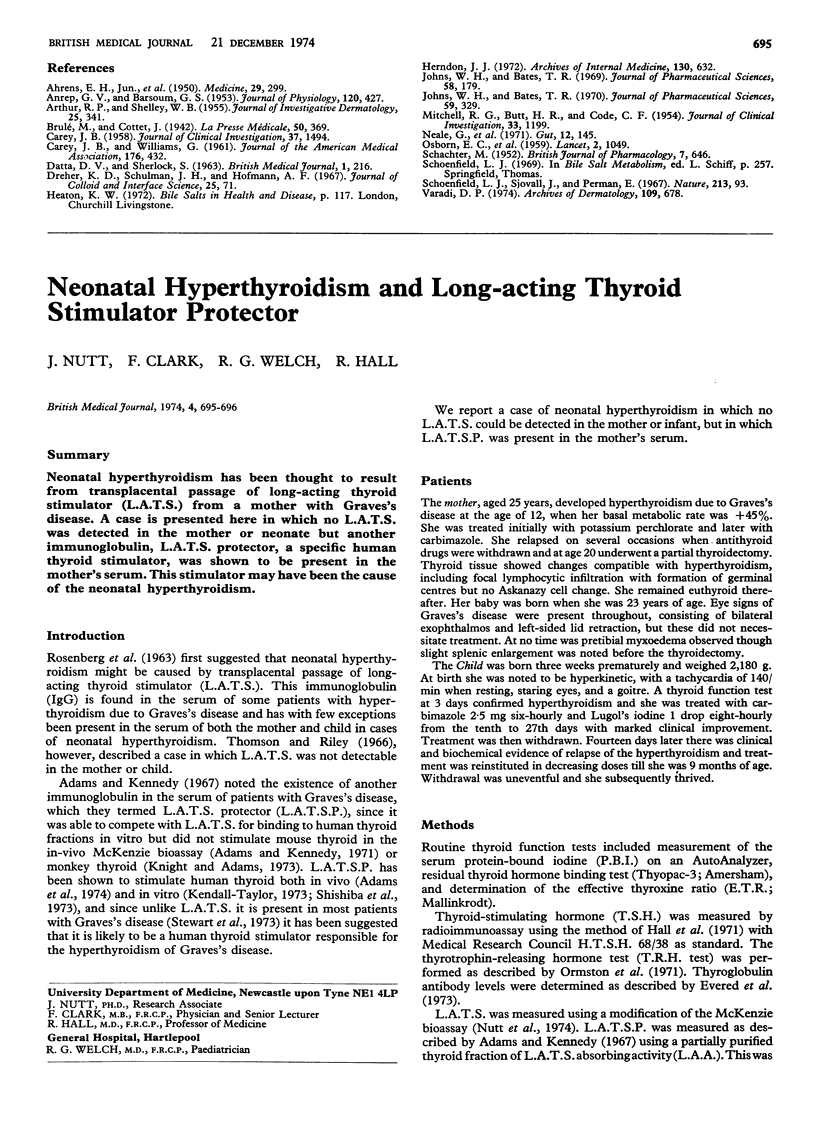Abstract
The pruritic effect of purified bile salts has been tested by applying them to blister bases. All the salts tested were pruritogens, but the dihydroxy salts (especially unconjugated chenodeoxycholate) were more effective than the trihydroxy salts. This may explain the poor correlation between total serum bile salt concentration and pruritus in obstructive jaundice.
Full text
PDF


Selected References
These references are in PubMed. This may not be the complete list of references from this article.
- AHRENS E. H., Jr, PAYNE M. A., KUNKEL H. G., EISENMENGER W. J., BLONDHEIM S. H. Primary biliary cirrhosis. Medicine (Baltimore) 1950 Dec;29(4):299–364. doi: 10.1097/00005792-195012000-00002. [DOI] [PubMed] [Google Scholar]
- ANREP G. V., BARSOUM G. S. Blood histamine in experimental obstruction of the common bile duct. J Physiol. 1953 May 28;120(3):427–430. doi: 10.1113/jphysiol.1953.sp004905. [DOI] [PMC free article] [PubMed] [Google Scholar]
- ARTHUR R. P., SHELLEY W. B. The role of proteolytic enzymes in the production of pruritus in man. J Invest Dermatol. 1955 Nov;25(5):341–346. doi: 10.1038/jid.1955.138. [DOI] [PubMed] [Google Scholar]
- CAREY J. B., Jr The serum trihydroxy-dihydroxy bile acid ratio in liver and biliary tract disease. J Clin Invest. 1958 Nov;37(11):1494–1503. doi: 10.1172/JCI103741. [DOI] [PMC free article] [PubMed] [Google Scholar]
- CAREY J. B., Jr, WILLIAMS G. Relief of the pruritus of jaundice with a bile-acid sequestering resin. JAMA. 1961 May 6;176:432–435. doi: 10.1001/jama.1961.03040180034008. [DOI] [PubMed] [Google Scholar]
- DATTA D. V., SHERLOCK S. Treatment of pruritus of obstructive jaundice with cholestyramine. Br Med J. 1963 Jan 26;1(5325):216–219. doi: 10.1136/bmj.1.5325.216. [DOI] [PMC free article] [PubMed] [Google Scholar]
- Herndon J. H., Jr Pathophysiology of pruritus associated with elevated bile acid levels in serum. Arch Intern Med. 1972 Oct;130(4):632–637. [PubMed] [Google Scholar]
- Johns W. H., Bates T. R. Quantification of the binding tendencies of cholestyramine. I. Effect of structure and added electrolytes on the binding of unconjugated and conjugated bile-salt anions. J Pharm Sci. 1969 Feb;58(2):179–183. doi: 10.1002/jps.2600580206. [DOI] [PubMed] [Google Scholar]
- Johns W. H., Bates T. R. Quantification of the binding tendencies of cholestyramine. II. Mechanism of interaction with bile salt and fatty acid salt anions. J Pharm Sci. 1970 Mar;59(3):329–333. doi: 10.1002/jps.2600590311. [DOI] [PubMed] [Google Scholar]
- MITCHELL R. G., BUTT H. R., CODE C. F. Histamine metabolism in diseases of the liver. J Clin Invest. 1954 Sep;33(9):1199–1203. doi: 10.1172/JCI102993. [DOI] [PMC free article] [PubMed] [Google Scholar]
- Neale G., Lewis B., Weaver V., Panveliwalla D. Serum bile acids in liver disease. Gut. 1971 Feb;12(2):145–152. doi: 10.1136/gut.12.2.145. [DOI] [PMC free article] [PubMed] [Google Scholar]
- OSBORN E. C., WOOTTON I. D., da SILVA L., SHERLOCK S. Serum-bile-acid levels in liver disease. Lancet. 1959 Dec 12;2(7111):1049–1053. doi: 10.1016/s0140-6736(59)91527-2. [DOI] [PubMed] [Google Scholar]
- SCHACHTER M. The release of histamine by pethidine, atropine, quinine, and other drugs. Br J Pharmacol Chemother. 1952 Dec;7(4):646–654. doi: 10.1111/j.1476-5381.1952.tb00733.x. [DOI] [PMC free article] [PubMed] [Google Scholar]
- Varadi D. P. Pruritus induced by crude bile and purified bile acids. Experimental production of pruritus in human skin. Arch Dermatol. 1974 May;109(5):678–681. [PubMed] [Google Scholar]


